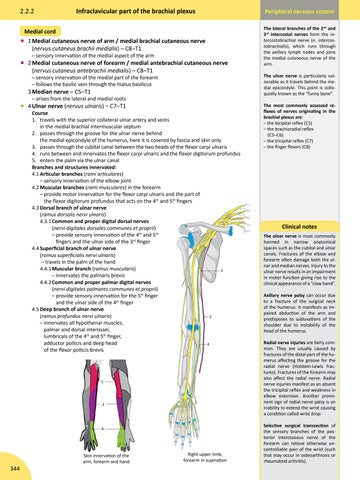2.2.2
Infraclavicular part of the brachial plexus
Medial cord • 1 Medial cutaneous nerve of arm / medial brachial cutaneous nerve (nervus cutaneus brachii medialis) – C8–T1 – sensory innervation of the medial aspect of the arm
• 2 Medial cutaneous nerve of forearm / medial antebrachial cutaneous nerve (nervus cutaneus antebrachii medialis) – C8–T1 – sensory innervation of the medial part of the forearm – follows the basilic vein through the hiatus basilicus
3 Median nerve – C5–T1
– arises from the lateral and medial roots
• 4 Ulnar nerve (nervus ulnaris) – C7–T1
Course 1. travels with the superior collateral ulnar artery and veins in the medial brachial intermuscular septum 2. passes through the groove for the ulnar nerve behind the medial epicondyle of the humerus, here it is covered by fascia and skin only 3. passes through the cubital canal between the two heads of the flexor carpi ulnaris 4. runs between and innervates the flexor carpi ulnaris and the flexor digitorum profundus 5. enters the palm via the ulnar canal Branches and structures innervated: 4.1 Articular branches (rami articulares) – sensory innervation of the elbow joint 4.2 Muscular branches (rami musculares) in the forearm – provide motor innervation for the flexor carpi ulnaris and the part of the flexor digitorum profundus that acts on the 4th and 5th fingers 4.3 Dorsal branch of ulnar nerve (ramus dorsalis nervi ulnaris) 4.3.1 Common and proper digital dorsal nerves (nervi digitales dorsales communes et proprii) – provide sensory innervation of the 4th and 5th fingers and the ulnar side of the 3rd finger 4.4 Superficial branch of ulnar nerve (ramus superficialis nervi ulnaris) – travels in the palm of the hand 4.4.1 Muscular branch (ramus muscularis) 1 – innervates the palmaris brevis 4.4.2 Common and proper palmar digital nerves (nervi digitales palmares communes et proprii) – provide sensory innervation for the 5th finger and the ulnar side of the 4th finger 4.5 Deep branch of ulnar nerve (ramus profundus nervi ulnaris) 2 – innervates all hypothenar muscles, palmar and dorsal interossei, lumbricals of the 4th and 5th finger, adductor pollicis and deep head 4 of the flexor pollicis brevis
1
2
4
344
Skin innervation of the arm, forearm and hand
Right upper limb, forearm in supination
Peripheral nervous system The lateral branches of the 2nd and 3rd intercostal nerves form the intercostobrachial nerve (n. intercostobrachialis), which runs through the axillary lymph nodes and joins the medial cutaneous nerve of the arm. The ulnar nerve is particularly vulnerable as it travels behind the medial epicondyle. This point is colloquially known as the “funny bone”. The most commonly assessed reflexes of nerves originating in the brachial plexus are: – the bicipital reflex (C5) – the brachioradial reflex (C5–C6) – the tricipital reflex (C7) – the finger flexors (C8)
Clinical notes The ulnar nerve is most commonly harmed in narrow anatomical spaces such as the cubital and ulnar canals. Fractures of the elbow and forearm often damage both the ulnar and median nerves. Injury to the ulnar nerve results in an impairment in motor function giving rise to the clinical appearance of a “claw hand”. Axillary nerve palsy can occur due to a fracture of the surgical neck of the humerus. It manifests as impaired abduction of the arm and predisposes to subluxations of the shoulder due to instability of the head of the humerus. Radial nerve injuries are fairly common. They are usually caused by fractures of the distal part of the humerus affecting the groove for the radial nerve (Holstein-Lewis fractures). Fractures of the forearm may also affect the radial nerve. Radial nerve injuries manifest as an absent the tricipital reflex and weakness in elbow extension. Another prominent sign of radial nerve palsy is an inability to extend the wrist causing a condition called wrist drop. Selective surgical transsection of the sensory branches of the posterior interosseous nerve of the forearm can relieve otherwise uncontrollable pain of the wrist (such that may occur in osteoarthrosis or rheumatoid arthritis).
